Click the points on the map to learn more.
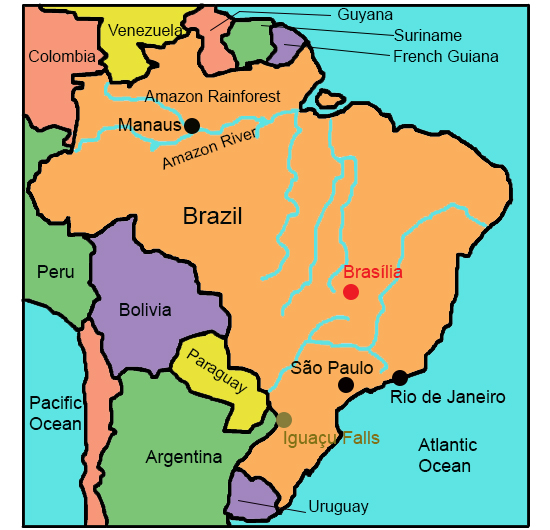
 |
Rio de JaneiroRio de Janeiro is named for a river that doesn’t exist. When Rio was discovered by Portuguese explorers in 1502, they named the spot “River of January,” because they believed the bay they found (now Guanabara Bay) was the mouth of a river (it’s not). Rio was the capital of Brazil from 1763 to 1960, and was also the official capital of the Portuguese empire from 1815 until Brazil’s independence from Portugal in 1822. Rio de Janeiro is the second largest city in the world and one of the largest cities in the southern hemisphere. It is the site of the 2016 Summer Olympics. |
| Back to Map | |
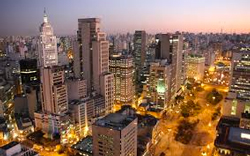 |
São PauloSão Paulo is the largest city in Latin America, with a population of 11.32 million. Like many cities in Brazil, São Paulo was founded by Jesuit Missionaries. The town was strategically located between the ocean and fertile lands to the west, and became an official city in 1711. Today, São Paulo is a culturally diverse city, and is animportant location for business and industry in Brazil. It the cultural hub of brazil and serves as an art, literature, and music center as well. |
| Back to Map | |
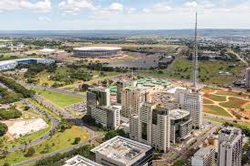 |
BrasíliaBrasília is the capital of Brazil, and its fourth largest city. It was established on April 21, 1960, after the government decided to move the capital from the coast to a more inland, central location. Brasília was meticulously designed and planned with a layout that features several sectors, such as the Embassy Sector, Banking Sector, and Hotel Sectors. The federal government offices are also located in Brasília. |
| Back to Map | |
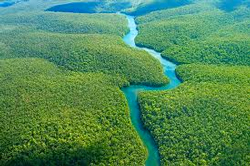 |
Amazon RiverThe Amazon River is the second longest river in the world, and is the largest river by volume. It discharges approximately 55 million gallons of water PER SECOND into the Atlantic Ocean. 20 percent of all freshwater that enters the ocean through rivers comes from the Amazon. Its course runs approximately 4,000 miles through South America, much of which is through Brazil. The Amazon holds over 3,000 recognized species of fish, with more still being discovered. |
| Back to Map | |
 |
Amazon RainforestThe Amazon is the world’s largest tropical rainforest. It covers 2.1 million square miles of land, primarily in Brazil, Peru, and Colombia. The Amazon is least 55 million years old, and is home to about 2.5 million insect species, as well as 40,000 different plant species and almost 1,300 different species of birds. The Amazon rainforest accounts for more than half of the world’s remaining rainforests. Scientists estimate the forest holds 390 billion individual trees of 16,000 different species. It is referred to as the ‘Lungs of the Planet,’ as it produces 20% of the world’s oxygen. |
| Back to Map | |
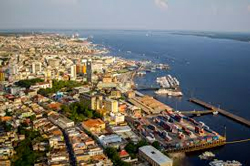 |
ManausWith a population of over two million people, Manaus is the largest city in the Amazon region. Despite its large population, the city is isolated and access to the city is accomplished via boat or airplane. In 2014, however, Manaus served as one of the host cities for the FIFA World Cup. Manaus also serves as the staging point for people trekking through the rainforest. |
| Back to Map | |
 |
Iguaçu FallsIguaçu Falls is one of the natural wonders of the world. Located on the border of Brazil and Argentina, Iguaçu is actually a system of many different waterfalls. It contains 275 falls along the Iguazu River, including the Devil’s Throat - a U-shaped waterfall 269 feet in height. |
| Back to Map | |
| Population: | 200,400,000 |
| Area: | 3,288,000 square miles |
| Capital City: | Brasilia |
| Largest City: | São Paulo |
| Currency: | Brazilian Real |
| Official Language: | Portuguese |
| GDP (Gross Domestic Product) | $2.246 trillion |
- “Brazil” comes from the brazil wood tree that used to grow plentifully along the coast of Brazil
- Brazil’s economy is larger than all other South America countries combined.
- Brazil is the largest producer of coffee in the world, and contributes 40% of the world’s total coffee supply
- The Amazon Rainforest drains 60 percent of the land in Brazil
- Football (soccer) is the most popular sport in Brazil, with their national team winning the World Cup a record five times
- Brazil is the fifth-largest country in the world, by both area and population
- Brazil shares common boundaries with every other South American country except Chile and Ecuador
- The largest statue of Jesus Christ in the world, Christ the Redeemer, stands 130 feet tall in Rio de Janeiro
- In the summer of 2016, Brazil will become the first South American nation to host the Summer Olympics.
- Brazil is the only nation in the Americas with Portuguese as the official language |
|
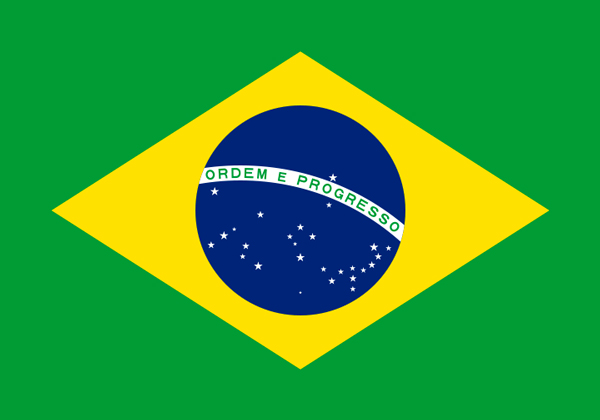 |
|
The green background represents Brazil’s forests, while the yellow rhombus represents its mineral wealth. The blue circle and stars depict the sky over Rio de Janeiro on the morning of November 15,1889 - the day the Republic of Brazil was declared. The current 27 stars represent each state and the Federal District. ORDEM E PROGRESSO means Order and Progress. |
|